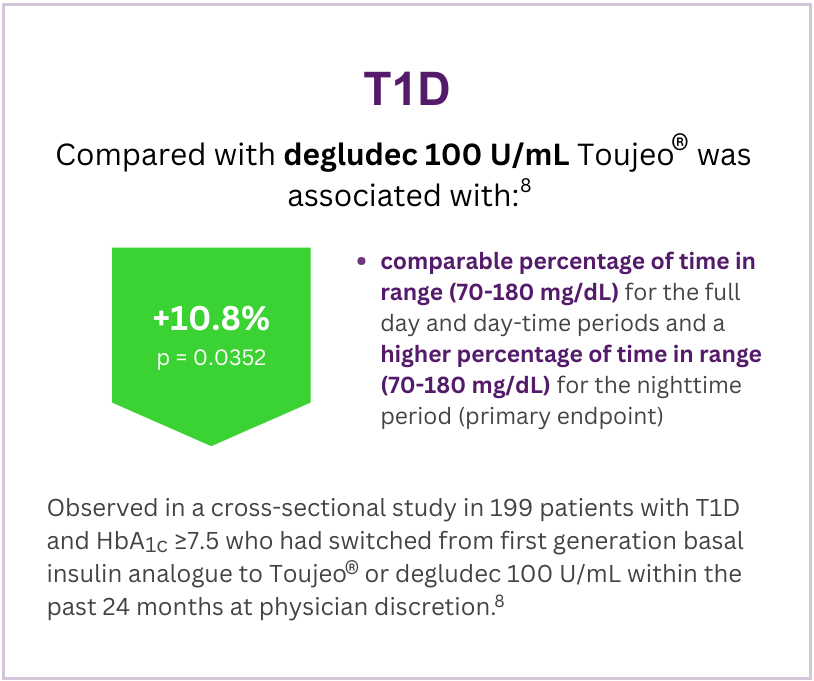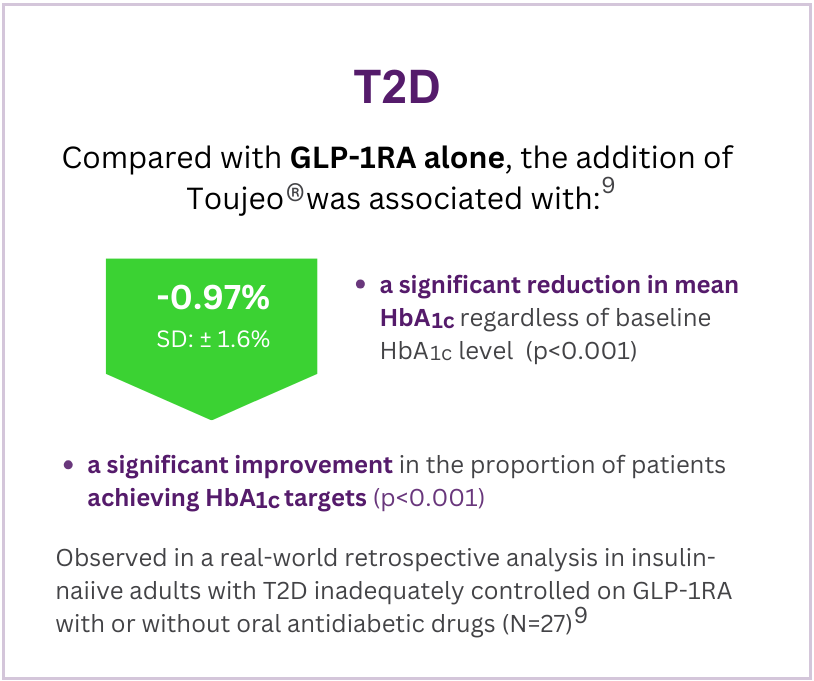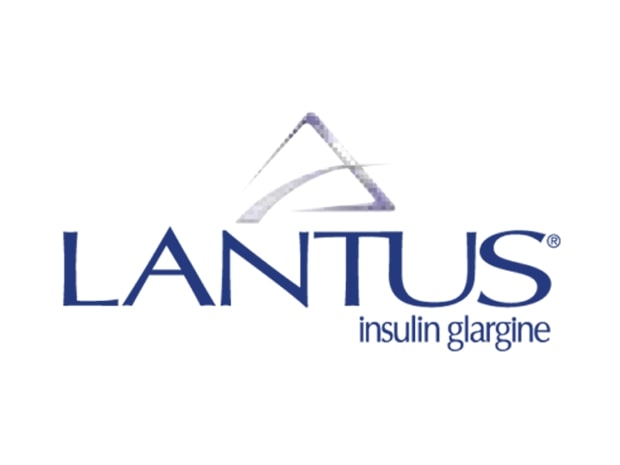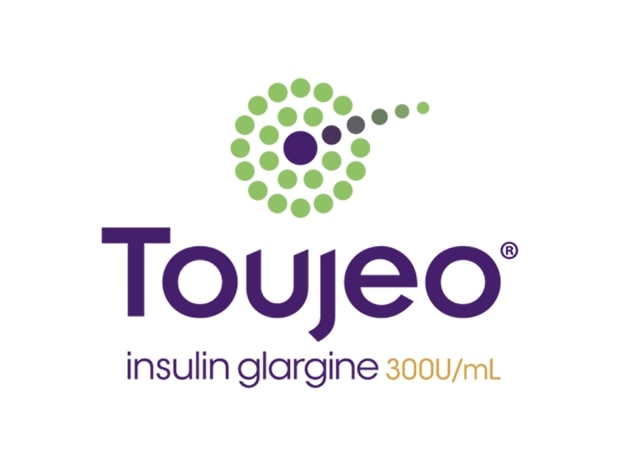- Article
- Source: Campus Sanofi
- 23 Oct 2023
Explore Toujeo (insulin glargine 300 Units/mL) data from the pivotal randomised controlled clinical trials

Prescribing information is available by clicking the links at the bottom of the page.
Hypoglycaemia is the most frequent adverse reaction observed in clinical trials conducted with Toujeo®.7 Other common adverse effects are lipohypertrophy and injection site reactions.7
For further information on the safety profile of Toujeo® please consult the Summary of Product Characteristics
ARR: Absolute Risk Reduction
HR: Hazard Ratio
OR: Odds Ratio
RR: Relative Risk
T1D – Type-1 Diabetes
T2D – Type -2 Diabetes
- Danne T, Matsuhisa M et al. Lower risk of severe hypoglycaemia with insulin glargine 300 U/mL versus glargine 100 U/mL in participants with type 1 diabetes: a meta-analysis of 6-month phase 3 clinical trials. Diabetes Obes Metab 2020;22(10):1880-1885
- Ritzel R, Roussel R et al. Patient-level meta-analysis of the EDITION 1, 2 and 3 studies: glycaemic control and hypoglycaemia with new insulin glargine 300 U/ml versus glargine 100 U/ml in people with type 2 diabetes. Diabetes Obes Metab 2015;17(9):859-867
- Ritzel R, Roussel R et al. Better glycaemic control and less hypoglycaemia with insulin glargine 300 U/mL vs glargine 100 U/mL: 1-year patient-level meta-analysis of the EDITION clinical studies in people with type 2 diabetes. Diabetes Obes Metab 2018;20(3):541-548
- Battelino T, Bosnyak Z et al. InRange: comparison of the second-generation basal insulin analogues glargine 300 u/ml and degludec 100 u/ml in persons with type 1 diabetes using continuous glucose monitoring-study design. Diabetes Ther 2020;11(4):1017-1027
- Battelino T, Danne T et al. Continuous glucose monitoring-based time-in-range using insulin glargine 300 units/ml versus insulin degludec 100 units/ml in type 1 diabetes: the head-to-head randomised controlled InRange trial. Diabetes Obes Metab 2023;25(2):545-555
- Rosenstock J, Cheng A et al. More similarities than differences testing insulin glargine 300 units/ml versus insulin degludec 100 units/ml in insulin-naive type 2 diabetes: the randomised head-to-head BRIGHT trial. Diabetes Care 2018;41(10):2147-2154
- Toujeo Summary of Product Characteristics
- Danne T, Tamborlane W V et al. Efficacy and safety of insulin glargine 300 units/ml (gla-300) versus insulin glargine 100 units/ml (gla-100) in children and adolescents (6-17 years) with type 1 diabetes: results of the EDITION JUNIOR randomised controlled trial. Diabetes Care 2020;43(7):1512-1519
- Home P D, Bergenstal R M et al. New insulin glargine 300 units/ml versus glargine 100 units/ml in people with type 1 diabetes: a randomised, phase 3a, open-label clinical trial (EDITION 4). Diabetes Care 2015;38(12):2217-2225
- Matsuhisa M, Koyama M et al. New insulin glargine 300 U/ml versus glargine 100 U/ml in Japanese adults with type 1 diabetes using basal and mealtime insulin: glucose control and hypoglycaemia in a randomised controlled trial (EDITION JP 1). Diabetes Obes Metab 2016;18(4):375-383
- Danne T, Matsuhisa M et al. Lower risk of severe hypoglycaemia with insulin glargine 300 U/mL versus glargine 100 U/mL in participants with type 1 diabetes: a meta-analysis of 6-month phase 3 clinical trials. Diabetes Obes Metab 2020;22(10):1880-1885 (suppl)
- Bolli G B, Riddle M C et al. New insulin glargine 300 U/ml compared with glargine 100 U/ml in insulin-naive people with type 2 diabetes on oral glucose-lowering drugs: a randomised controlled trial (EDITION 3). Diabetes Obes Metab 2015;17(4):386-394
- Riddle M C, Bolli G B et al. New insulin glargine 300 units/mL versus glargine 100 units/mL in people with type 2 diabetes using basal and mealtime insulin: glucose control and hypoglycemia in a 6-month randomised controlled trial (EDITION 1). Diabetes Care 2014;37(10):2755-2762
- Yki-Jarvinen H, Bergenstal R et al. New insulin glargine 300 units/mL versus glargine 100 units/mL in people with type 2 diabetes using oral agents and basal insulin: glucose control and hypoglycemia in a 6-month randomised controlled trial (EDITION 2). Diabetes Care 2014;37(12):3235-3243
- Ritzel R, Roussel R et al. Better glycaemic control and less hypoglycaemia with insulin glargine 300 U/mL vs glargine 100 U/mL: 1-year patient-level meta-analysis of the EDITION clinical studies in people with type 2 diabetes. Diabetes Obes Metab 2018;20(3):541-548 (suppl)
- Battelino T, Danne T et al. Time in range using insulin glargine 300 U/mL versus insulin degludec 100 U/mL in type 1 diabetes: head-to-head randomised controlled InRange trial. Presented at Advanced Technologies and Treatments for Diabetes conference, Barcelona, Spain, 27-30 April 2022; abstract LB009/ #1015
- Rosenstock J, Cheng A et al. More similarities than differences testing insulin glargine 300 units/ml versus insulin degludec 100 units/ml in insulin-naive type 2 diabetes: the randomised head-to-head BRIGHT trial. Diabetes Care 2018;41(10):2147-2154 (suppl)
- Cheng A, Harris S et al. Similar glycaemic control and less hypoglycaemia during active titration after insulin initiation with glargine 300 units/mL and degludec 100 units/mL: a subanalysis of the BRIGHT study. Diabetes Obes Metab 2020;22(3):346-354
- Sanofi. Efficacy and safety of Toujeo® versus Tresiba® in insulin-naïve patients with type 2 diabetes mellitus inadequately controlled with oral antihyperglycemic drug(s) ± glp-1 receptor agonist (BRIGHT). Available at: clinicaltrials.gov. Accessed October 2024
- Bolli G B, Cheng A. Lower hypoglycaemia rates with insulin glargine 300 U/ml vs insulin degludec 100 U/ml in insulin-naive adults with T2DM: the BRIGHT randomised trial. Presented at EASD, Berlin, Germany, 1-5 October 2018; poster 896
Diabetes Products
MAT-XU-2302857 (v6.0) Date of Preparation: October 2024


.png)
.png)
.png)


